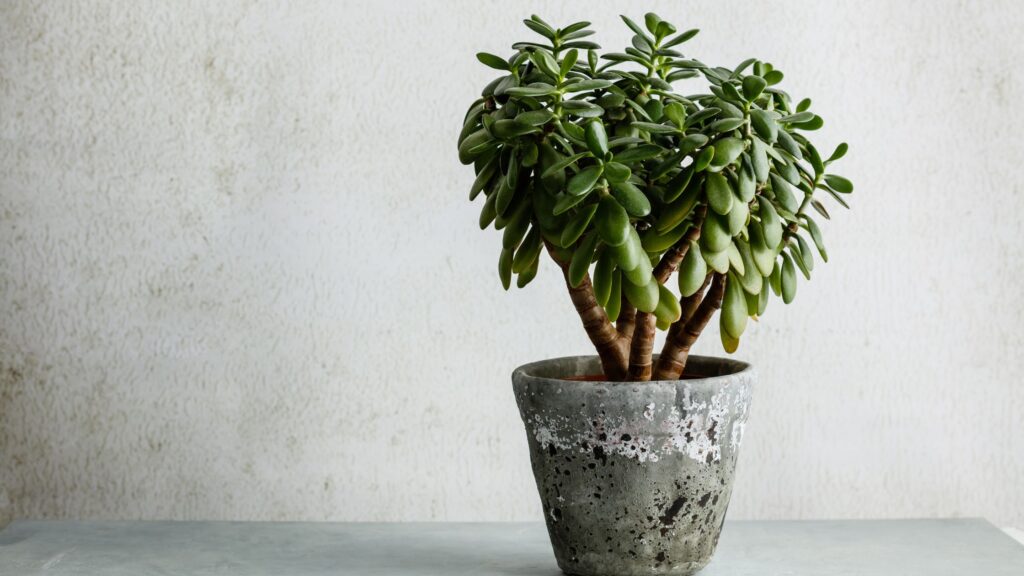Jade Plant flowers
Jade plants (also known as money plants) are popular succulent houseplants with fleshy green leaves. While they are primarily known for their glossy green foliage, they can also produce beautiful star-shaped flowers. Here’s what you need to know about jade plant flowers:
- Blooming Period:
- Jade plants typically bloom in their native habitat (South Africa) during winter, from June to August.
- In the northern hemisphere, indoor jade plants may flower sometime during late winter to early spring, usually between late December and February.
- Flower Appearance:
- The flowers are small, star-shaped, and can be white or delicate pink.
- Flowers begin as buds buried within pink sepals.
- Encouraging Blooms:
- Jade plants need specific conditions to bloom:
- Maturity: Younger jade plants are less likely to bloom. They need to be at least three to four years old.
- Humidity: Jade plants prefer low humidity levels, similar to their native environment.
- Light: Provide at least six hours of bright, indirect sunlight daily. Too little light can hinder flowering.
- Water: Reduce watering slightly to create a bit of stress, encouraging blooming
- Jade plants need specific conditions to bloom:

Jade Plant Propagation
Here’s all you need to know about jade plant propagation:
- Stem Cutting Method:
- Choose a Branch: Look for a healthy stem that is at least 3-4 inches long.
- Make the Cutting: Use clean clippers or scissors to take the cutting.
- Remove Leaves: Remove some leaves from the stem, leaving the nodes where the roots will grow.
- Let It Cure: Allow the stem to dry out slightly before propagating it to prevent rot.
- Rooting: Place the stem cutting in water or soil. It takes about 2-3 weeks for roots to grow.
- Leaf Cutting Method:
- Select Leaves: Carefully break off full leaves from the stem.
- Rooting: You can root leaf cuttings in either soil or water, but soil is easier.
- Patience: Leaf propagation may take longer than stem propagation.
- Natural Propagation: In the wild, jade leaves that fall on the ground can root themselves without human intervention.
Jade Plant Benefits
Here’s a summary of some of the main benefits:
- Air Purification: Jade plants act as natural air purifiers, helping to remove toxins like formaldehyde and benzene from the air, creating a healthier indoor environment.
- Improved Humidity: These plants can also increase humidity levels, which can be beneficial for people with respiratory issues and may help maintain healthy skin.
- Positive Symbolism: In Feng Shui, jade plants are believed to attract wealth and prosperity, while also promoting positive energy flow. They are popular gifts for housewarmings and new beginnings .
- Low Maintenance: A major benefit is that jade plants are known for being easy to care for. They require little water and may flourish under a range of lighting conditions.
Jade Plant Disadvantages
Before taking one home, you should consider the following:
- Light Needs: Jade plants prefer several hours of bright, indirect sunlight daily. Homes with limited natural light may not be ideal.
- Overwatering Sensitivity: Overwatering is a common killer of jade plants. Their succulent leaves store water, so they need infrequent watering and well-draining soil to prevent root rot.
- Toxic to Pets: Be aware that jade plant leaves are toxic to pets like cats and dogs.If ingested, they can cause vomiting, lethargy, and coordination issues.Keep the plant out of reach of curious animals.
The Best Soil For a Jade Plant
Jade plants, like most succulents, are susceptible to rot if their roots sit in water for too long.
Here’s what to look for in a jade plant’s soil:
- Succulent or Cactus Mix: This is the easiest option and the most recommended. These pre-mixed options are formulated to drain quickly and provide good aeration for succulent roots.
- DIY Mix: If you want to make your own mix, combine:
- Potting soil: Provides some organic matter and nutrients.
- Perlite or pumice: These inorganic volcanic rocks create large air pockets in the soil for drainage and aeration.
- Sand (optional): While sometimes used, sand can compact over time and reduce drainage. Perlite or pumice are generally preferred.
Curly Jade Plant
Curly Jade Plant (also known as Crassula ovata Undulata) is a captivating succulent with unique wavy or undulating leaves. Here’s how to care for it:
- Light:
- Curly Jade thrives in indirect sunlight for most of the day and a few hours of direct sunlight.
- It can tolerate some shade, but too little light may cause the purple tips to fade.
- Water:
- Let the top 3 inches of soil dry before watering.
- Bottom watering is ideal to prevent wet leaves.
- They’re drought-tolerant, so don’t worry about overwatering.
- Climate:
- Regular household conditions (60°F-75°F) suit them well.
- Humidity isn’t critical, but they don’t mind occasional boosts.
- Soil:
- Use well-draining sandy soil to prevent excess water retention.
- Curly Jade can handle water storage on its own
Trailing Jade
The Trailing Jade (also known as Peperomia rotundifolia) is a delightful succulent with thick, rounded leaves. Here’s how to care for it:
- Light:
- Trailing Jade thrives in indirect sunlight for most of the day and can tolerate a few hours of direct sunlight.
- It’s best to avoid intense, scorching sun exposure.
- If you notice leggy growth, consider providing more light.
- Water:
- Allow the top 1-2 inches of soil to dry out before watering.
- Water sparingly during winter when growth slows down.
- Avoid overwatering to prevent root rot.
- Climate:
- Trailing Jade prefers average room temperatures (around 65°F-75°F or 18°C-24°C).
- It appreciates higher humidity levels but can adapt to normal household humidity.
- Soil:
- Use well-draining soil, such as a mix of potting soil and perlite.
- Repot every 2-3 years to renew the soil and give the plants more room to flourish.


